分享到
Inhibiting Interfacial Diffusion in Heterojunction Perovskite Solar Cells by Replacing Low‐Dimensional Perovskite with Uniformly Anchored Quaternized Polystyrene
2023
期刊
Small
作者
Congcong Tian
· Anxin Sun
· Jianghu Liang
· Zhanfei Zhang
· Yiting Zheng
· Xueyun Wu
· Yuan Liu
· Chen Tang
· Chun-Chao Chen
- 卷 19
- 期 32
- Wiley
- ISSN: 1613-6810
- DOI: 10.1002/smll.202301091



